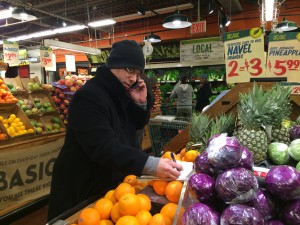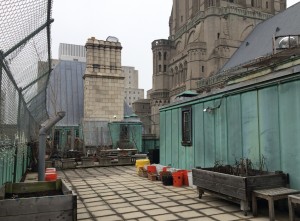Justice at the Table
Eating is not only personal. It is also political, connected as it is to social-economic inequalities and racial differences. Responding to the emerging food movement, which mainly critiques the dominant food system, the food justice movement took root in historically marginalized and low-income communities of color to challenge racial and economic food inequality and to achieve long-term sustainability by establishing ecologically sustainable food systems.
As a set of social relations and cultural practices, the ways in which food is produced and distributed foster community and also contribute to cultural identities. Healthy food is a fundamental right rather than a mere commodity. The food justice movement advocates for food sovereignty, where people have equal access to healthy and affordable food by controlling its cultivation and distribution.
One active organization in the food justice movement in New York City is the Edible Churchyard at Union Theological Seminary (UTS), which places particular significance on the spiritual aspects of cultivating justice, connecting its vision to the powerful activism around racial justice, feminism, sexual equality, and the well-being of the poor and the oppressed.
Edible Schoolyard
Activities of the Edible Churchyard, New York, NY, April 6, 2015, illustration by Yuanxie Shi.
Civil society grows in community, school, and church gardens. Like many community gardens, school and church gardens invite people in the community to share the common experiences of getting their hands muddy, cultivating pride in producing nutritious food, and revitalizing patches of land.
One of the most influential and longest-running school garden programs in the country is the Edible Schoolyard, which was initiated by chef and Slow Food advocate Alice Waters in Berkeley, California, in 1995. Children at the Martin Luther King Middle School learn how to cultivate and prepare food by themselves in the school’s one-acre organic garden and kitchen classroom. The garden was envisioned as an opportunity to teach students about environmental sustainability and how growing food promotes the social well-being of the school community. As a cooperative approach to relieve the competitive pressures of the classroom, students learn together how to experience success step by step. The success of the Edible Schoolyard project sparked similar teaching gardens across the country that receive support from Waters’s Chez Panisse Foundation, which she established in 1996.
Perhaps the greatest resonance between the Edible Schoolyard and the Edible Churchyard is their shared underlying philosophy: respect for the earth and the connections between land, food, and community. But the Edible Churchyard adds a spiritual dimension to gardening: it brings together food and faith in relation to the earth and seeks to foster a compassionate attitude in working toward a solution to the ecological crisis.
Rituals at the Table
Activities of the Edible Churchyard, New York, NY.
The Edible Churchyard developed out of the belief that food justice is an inseparable part of social justice. It is located at Union Theological Seminary, which embraces seminarians from different religious and social backgrounds. Graduate students and theologians approach the cultivation of UTS’s rooftop growing spaces as a sacred art. By adopting the principles of eco-theology in their gardening activities, they demonstrate a more sensitive connection between humans and the earth than that of industrial agriculture.
Preparing for the first community dinner of 2015, Christopher Fici, student project manager of the Edible Churchyard, chose ingredients for the meal with great care. While he and other UTS community members were cooking together, the group talked about their relationship to food: What have human beings done to food? What is our food culture? Each member recalled memories of food and shared personal stories. Fici treasures every opportunity to have such intimate conversations with members who share a mutual interest in the Edible Churchyard.
Food sharing not only cements bonds within a community, but it also extends contemplation and gratitude. At a recent communion service, Union seminarians sang hymns, praying for the good weather and a heavy harvest this year. Chris Fici read a verse from the Bhagavad Gita, a fundamental text of Hinduism, the religion that he practices. Fresh bread, apples, and drinks from Bluestone Farm and Living Arts Center, an edible churchyard in Brewster, New York, were shared with love and satisfaction.
Present and Future
The Edible Churchyard, New York, NY.
As the student leader of the Edible Churchyard, Fici tries to put eco-theology into practice. He also works with the Corbin Hill Food Project (CSA) and West Harlem Environmental Action to support food justice initiatives in nearby neighborhoods. In his work at UTS, he is concerned with sustaining student leadership in Union’s work and inspiring New York religious institutions to develop gardening programs. Although churches have consulted him about how to garden in their churchyards, many of their clergy and congregations need to be trained how to garden.
Food justice is a way the Edible Churchyard connects spirituality to more powerful social activism in this city. -Y.S.





